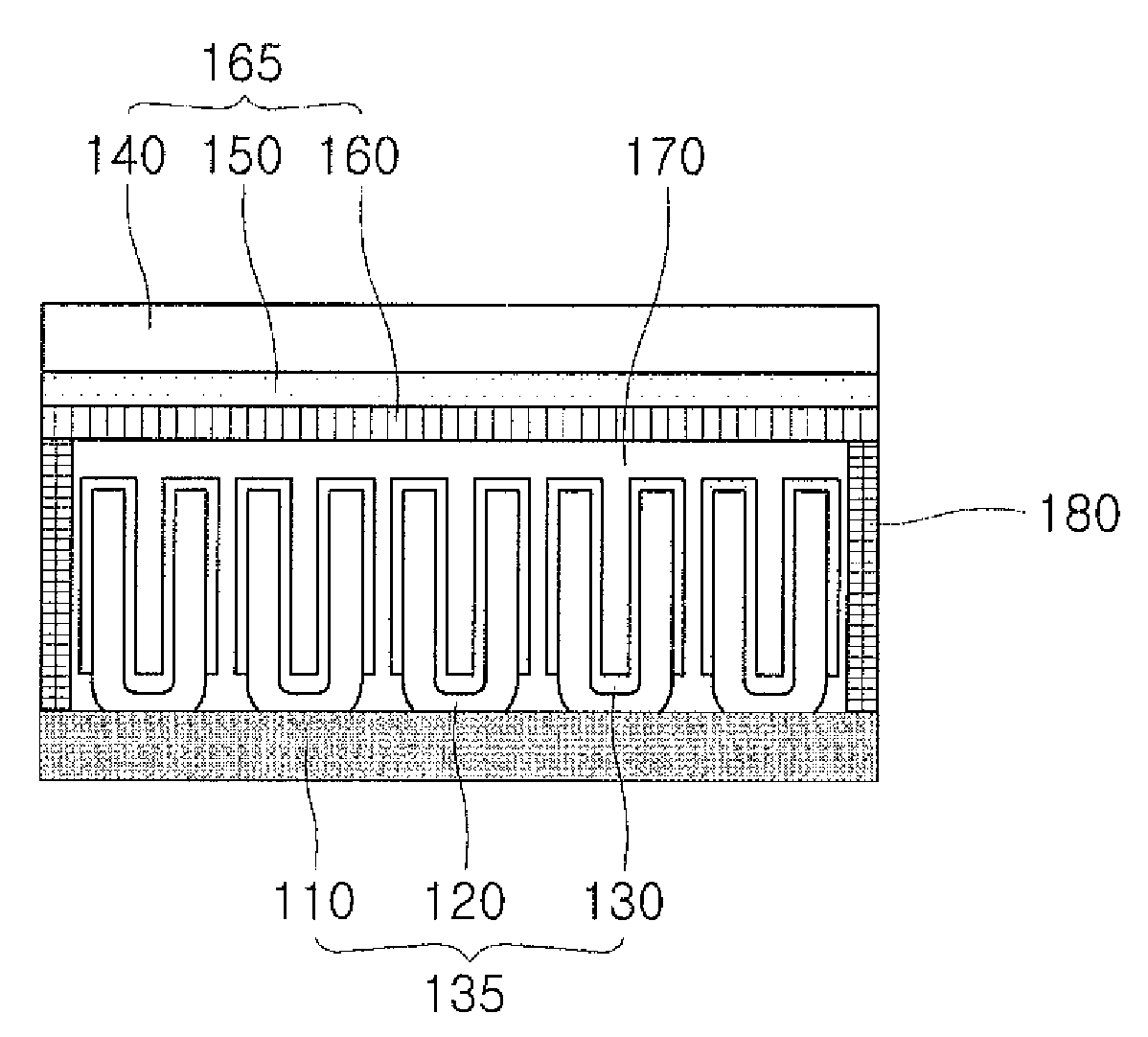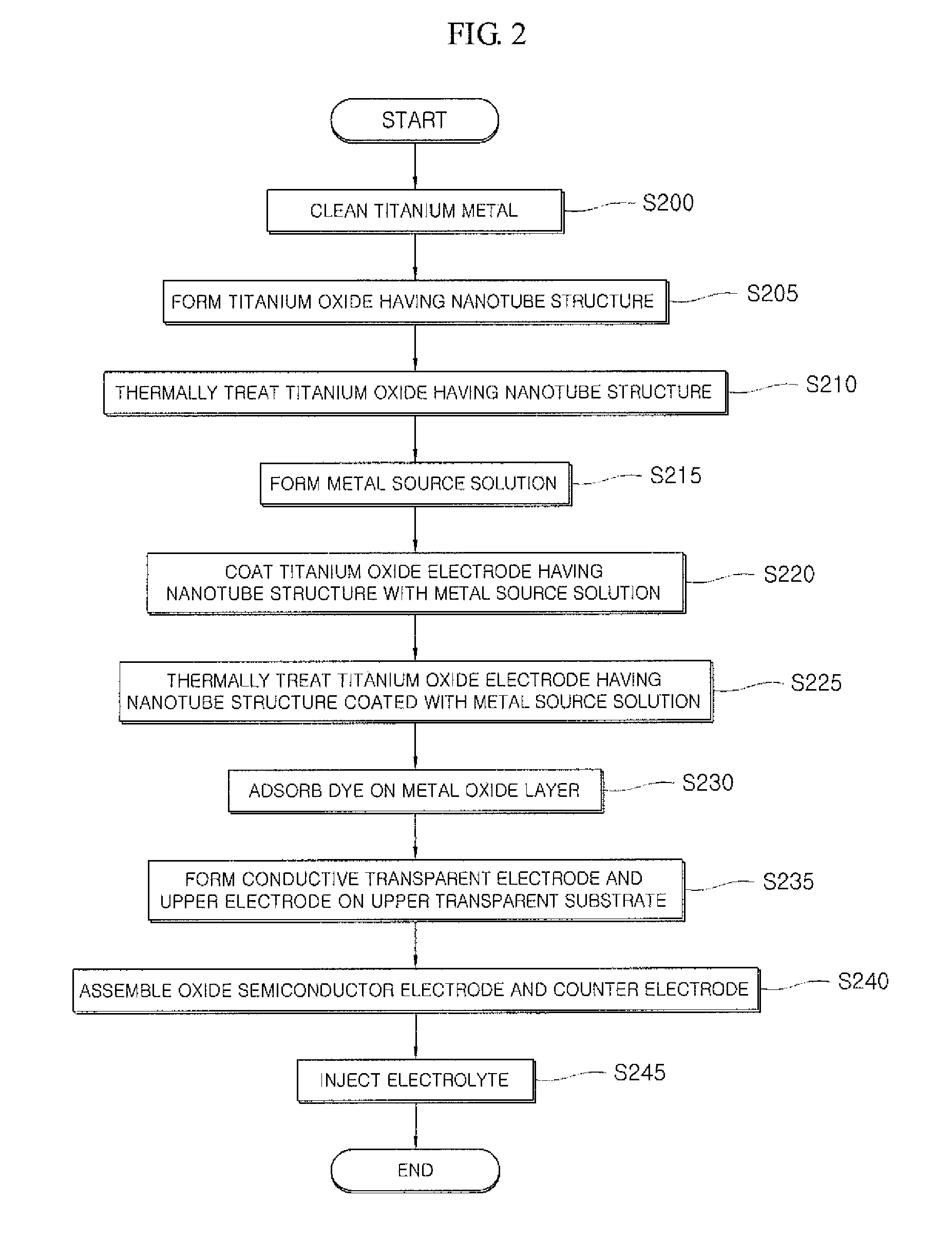Dye-Sensitized Solar Cell and Method of Manufacturing the Same
a solar cell and dye sensitization technology, applied in the direction of final product manufacturing, sustainable manufacturing/processing, superimposed coating process, etc., can solve the problem of limited increase in energy conversion efficiency using only titanium oxide, high chance of recombination of electrons with electrolytes, and obstacle to higher light-electricity conversion efficiency in nanocrystalline structures. achieve the effect of increasing energy conversion efficiency, easy adsorption of dyes, and increasing solar light absorption
- Summary
- Abstract
- Description
- Claims
- Application Information
AI Technical Summary
Benefits of technology
Problems solved by technology
Method used
Image
Examples
experimental example 1
[0091]By a method in which steps S215, S220 and S225 were omitted from the embodiment, a solar cell was manufactured using a titanium oxide electrode which was not coated with magnesium oxide, and its photo current-voltage characteristics were measured. FIG. 6(a) shows the photo current-voltage characteristics of a dye-sensitized solar cell manufactured using a nanotube titanium oxide electrode having a thickness of 8.55 μm which was measured under the condition of AM 1.5, 100 mW / cm2, and Table 1 shows photoelectrical characteristic results calculated from FIG. 6(a).
TABLE 1Short-circuitEnergyOpen-circuitCurrent DensityConversionVoltage (Voc)(Jsc, mA / cm2)Fill FactorEfficiency (%)0.540.5454.230.16
[0092]The solar cell according to Experimental Example 1 was manufactured under conditions as follows. An ethylene glycol organic solution was used as an electrolyte to perform anodizing, and 0.25 wt % NH4F was used as a fluoride source solution. In order to form a nanotube, a voltage differe...
experimental example 2
[0093]According to another exemplary embodiment, a solar cell was manufactured using a titanium oxide electrode coated with magnesium oxide, and its photo current-voltage characteristics were measured. FIG. 6(b) shows the photo current-voltage characteristics of a dye-sensitized solar cell manufactured using the magnesium oxide-coated nanotube titanium oxide electrode having a thickness of 8.55 μm which was measured under the condition of AM 1.5, 100 mW / cm2, and Table 2 shows photoelectrical characteristic results calculated from FIG. 6(b). The measurement condition is the same as that of Experiment Example 1, and the results are shown in Table 2.
TABLE 2Short-circuitOpen-circuit VoltageCurrent DensityFillEnergy Conversion(Voc)(Jsc, mA / cm2)FactorEfficiency (%)0.733.7359.581.61
[0094]The solar cell according to Experimental Example 2 was manufactured under conditions as follows. An ethylene glycol organic solution was used as an electrolyte to perform anodizing, and 0.25 wt % NH4F was ...
PUM
| Property | Measurement | Unit |
|---|---|---|
| inner diameter | aaaaa | aaaaa |
| thickness | aaaaa | aaaaa |
| temperature | aaaaa | aaaaa |
Abstract
Description
Claims
Application Information
 Login to View More
Login to View More - R&D
- Intellectual Property
- Life Sciences
- Materials
- Tech Scout
- Unparalleled Data Quality
- Higher Quality Content
- 60% Fewer Hallucinations
Browse by: Latest US Patents, China's latest patents, Technical Efficacy Thesaurus, Application Domain, Technology Topic, Popular Technical Reports.
© 2025 PatSnap. All rights reserved.Legal|Privacy policy|Modern Slavery Act Transparency Statement|Sitemap|About US| Contact US: help@patsnap.com



